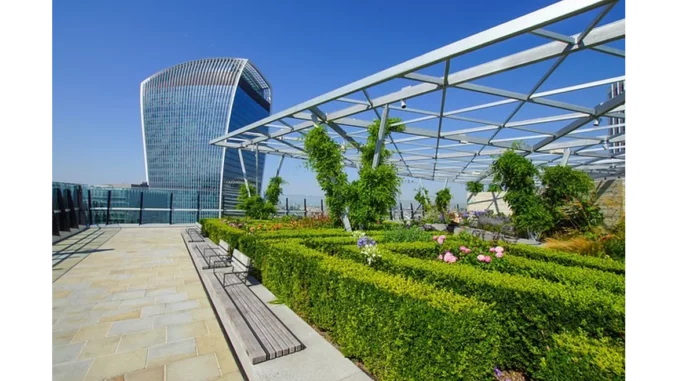
Imagine standing on a rooftop amidst a sea of concrete, only to find yourself surrounded by lush greenery and vibrant flowers. This captivating scene isn’t a daydream but a reality that many urban dwellers are embracing. To delve deeper into the transformative world of rooftop gardens, I had the pleasure of speaking with Emily Harper, an expert landscape architect at Borst Landscape & Design. Our conversation revealed invaluable insights into the benefits and intricacies of creating these green oases in the sky.
A Serene Escape from Urban Chaos
Emily began by painting a vivid picture of the mental health benefits associated with rooftop gardens. “The modern urban lifestyle is often hectic and stressful,” she remarked. “A rooftop garden offers a tranquil escape, a place where people can unwind and reconnect with nature without leaving the city.”
She shared findings from a study by the University of Exeter Medical School, highlighting that regular exposure to green spaces significantly reduces stress levels and enhances overall happiness. “It’s not just about aesthetics,” Emily emphasised. “A well-designed rooftop garden can improve the mental well-being of anyone who spends time there, whether it’s a private residence or a corporate office.”
Breathing Easier with Improved Air Quality
One of the most fascinating aspects of rooftop gardens is their ability to improve air quality. Emily explained, “Plants are natural air purifiers. Through photosynthesis, they filter out pollutants and release oxygen, making the air cleaner and fresher.”
While a single rooftop garden might seem like a small effort, Emily pointed out that the collective impact could be substantial. “Imagine an entire city with green rooftops. The cumulative effect on air quality would be significant, benefiting everyone who breathes that air.”
Harnessing Rainwater Effectively
Rainwater management is another compelling argument for rooftop gardens. Emily detailed how these gardens can retain a large percentage of rainfall, which is particularly beneficial in urban areas prone to flooding. “During summer, rooftop gardens can retain up to 80% of rainfall, and around 40% in winter,” she noted.
These gardens not only reduce the volume of water runoff but also improve the quality of the water that does run off. “The plants and soil act as natural filters, which means any water that eventually reaches the drainage system is much cleaner,” Emily elaborated. This process helps in mitigating the impact on local waterways and reduces the strain on urban drainage systems.
Combating the Urban Heat Island Effect
Urban areas often experience higher temperatures than their rural counterparts, a phenomenon known as the Urban Heat Island (UHI) effect. Emily explained how rooftop gardens play a crucial role in controlling this effect. “Plants cool the air through the process of evapotranspiration. When you cover concrete rooftops with greenery, you significantly lower the surrounding temperature.”
This cooling effect can lead to a reduction in the use of air conditioning, which not only saves energy but also lowers electricity costs. “It’s a win-win situation,” she affirmed. “You get a beautiful green space and contribute to energy efficiency.”
Energy Efficiency and Insulation
Speaking of energy efficiency, Emily highlighted the insulating properties of rooftop gardens. “Green roofs provide excellent insulation for buildings. They help retain heat during the winter and keep interiors cool during the summer,” she said.
Studies, including one by the National Research Council of Canada, support this claim, showing how green roofs moderate temperature fluctuations. “This reduced need for heating and cooling translates to energy savings and a lower carbon footprint,” Emily added.
Promoting Urban Agriculture
Rooftop gardens can also serve as urban farms, a concept that Emily is particularly passionate about. “Growing food on rooftops is an excellent way to support the local food movement,” she enthused. “It reduces the need for transportation and packaging, making it a more sustainable option.”
She shared examples of rooftop gardens producing fresh vegetables and herbs, providing city dwellers with access to locally-grown produce. “It’s a fantastic way to bring agriculture into the urban environment,” Emily concluded.
Reducing Noise Pollution
Another lesser-known benefit of rooftop gardens is their ability to reduce noise pollution. Emily explained, “The combination of soil and plants can absorb, reflect, or deflect sound waves. This is especially beneficial in noisy urban areas or near airports.”
By creating a quieter environment, rooftop gardens contribute to a more pleasant living or working space. “It’s one of those benefits that people might not immediately think of, but once they experience it, they can’t imagine going back,” she said with a smile.
Creating Wildlife Habitats
Lastly, Emily spoke about the ecological impact of rooftop gardens. “These green spaces can become sanctuaries for various types of wildlife,” she noted. “Birds, insects, and other small creatures can find shelter and food in these gardens, enhancing urban biodiversity.”
She also mentioned that rooftop gardens could serve as stopovers for migrating species, providing much-needed respite in the midst of the urban jungle. “By creating these habitats, we’re contributing to the overall health of our urban ecosystems,” Emily concluded.
Conclusion
As my conversation with Emily Harper from Borst Landscape & Design drew to a close, it became clear that rooftop gardens offer a myriad of benefits, from improving mental health and air quality to promoting urban agriculture and biodiversity. These green oases are more than just a trend; they’re a sustainable solution for enhancing urban living. Whether you’re looking to create a personal sanctuary or a functional space for urban farming, the possibilities are endless.
If you’re considering transforming your rooftop into a green oasis, take a leaf out of Emily’s book and explore the myriad benefits that await you.
Written by Jade Thompson.


Be the first to comment